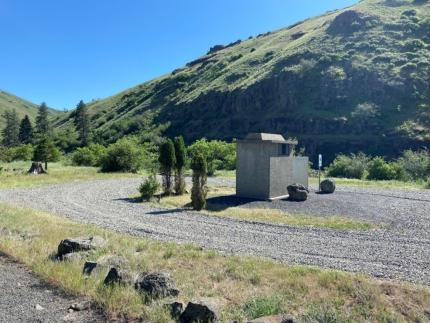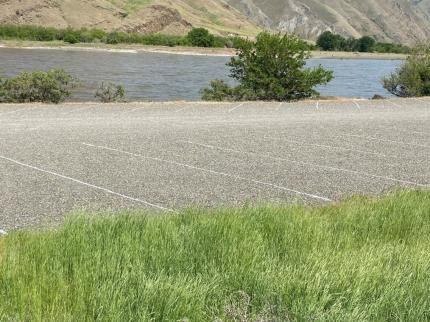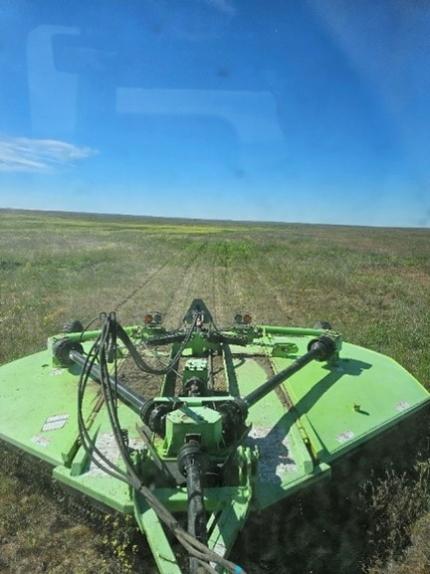Managing Wildlife Populations
Vulcan Bighorn Sheep Habitat Tour: Wildlife Biologist Prince toured a Department of Natural Resources (DNR) parcel within the core use area of the Vulcan Bighorn Sheep Herd. The tour was attended by DNR staff members, Washington Department of Fish and Wildlife staff members, and Confederated Tribes of the Colville Reservation staff members. The group would all like to see some habitat improvements (timber harvest) occur on the parcel and will be working together to explore funding opportunities. Access to the site is limited and may require helicopter logging which is quite expensive.

Sharp-tailed Grouse: Biologist Lowe investigated the last recorded location of a male sharp-tailed grouse in Lincoln County. The bird, wearing a GPS transmitter as part of the April translocation from British Columbia, had not reported a location in several days. A roost pile was found but there was no transmitter or sign of mortality.
Biologist Brinkman investigated the last recorded location of a different sharp-tailed grouse that had not uploaded any new locations in over a week. This one was on private land in Lincoln County. No sign of grouse activity was discovered in the vicinity of the last location.
Biologist Brinkman also conducted a sharp-tailed grouse lek search northeast of Creston. One of the male grouse translocated from British Columbia in April has remained in a relatively small area between two historic leks for over a week based on GPS locations from its transmitter. This behavior could indicate lek activity at this location and warranted an investigation. This area is primarily private land, so this initial survey was conducted from the road, but no birds were heard or observed during this visit.
Moose: Yearling twin moose visited the neighbors near the Last Resort Campground this week.
Providing Recreation Opportunities
Recreational Access Area Maintenance and Management: Maintenance Mechanic Heimgartner and Natural Resource Technician Nielsen cleaned and maintained access sites on the Snake River, Grande Ronde River, Asotin Creek, Wooten Lakes, and campgrounds. They picked up litter, cleaned toilets, sprayed weeds, and trimmed branches. They also painted parking lines at Heller Bar in preparation for the busy summer boating and rafting season. There was some enhancement funding available for gravel delivery to Cougar Creek. Staff members evenly spread the gravel across the parking area.


Reardan Audubon Work: Access Manager Dziekan and Natural Resource Technician Brant have been working hard on grass and weed control at Reardan Audubon Lakes Wildlife Area. Dziekan and Brant applied a couple rounds of herbicide over the last month, and this week started the cutting process. The work has been on the southern parking area only. Dziekan and Brant mowed the entrance, string trimmed the interior perimeter of the parking area, and string trimmed along the fence line leading to the blind. The plan is to come back with some more herbicide to control the grass along the fence line that is growing in the rip-rap rock.
Spading’s Catchfly Working Group Annual Meeting: Assistant Wildlife Area Manager Woodall spent two days with the Spalding’s Catchfly Working Group at their annual meeting in Moscow, Idaho. There was a field trip to some silene restoration sites in remnant Palouse Prairie.


Providing Conflict Prevention and Education
Garfield County Bear Issue: Wildlife Conflict Specialist Wade received a report of a bear in the Bakers Pond area getting into trash cans at multiple cabins. Wade spoke with the reporting party who said that he had been putting out corn for deer and the bear had been observed feeding on it as well. Wade discussed the issues with putting out attractants for wildlife and that in most cases it is more of a harm for wildlife than help. The reporting party agreed to clean up the corn. Wade also directed the reporting party to haze the bear if it returned.

Wolf Non-Lethal Deterrents: Wildlife Conflict Specialist Kolb assisted a producer who is actively calving in Columbia Pack territory with the deployment of non-lethal deterrents on the landscape. The producer is interested in entering into a Damage Prevention Cooperative Agreement for livestock which will provide cost-sharing measures for the use of additional non-lethal tools.

Bear Issues: Conflict staff members in Districts 1 and 3 have been responding to a lot of bear issues.
Black Bear Damage: Wildlife Conflict Specialist Kolb was contacted by a Walla Walla County strawberry producer who experiences significant black bear damage on their mountain strawberry fields every year. Kolb lent the producer some electric fencing supplies to help get through another season.
Conserving Natural Landscapes
Prescribed Burn Completion: Washington Department of Fish and Wildlife (WDFW) fire staff members carried out the long-planned prescription burn at part of Rustlers Gulch Wildlife Area on May 14 and 15. They burned over 250 acres! Rainfall during the previous weeks kept the underlying soil damp, while allowing surface duff to dry out. This minimized the loss of large living trees, while meeting the objective of removing duff and smaller-sized vegetation. Of the few large trees that did burn down, most were Douglas firs, not Ponderosa pines. Sherman Creek Wildlife Area Assistant Manager Palmer, who holds a current firefighter’s Red Card, helped with several tasks, including igniting vegetation. Approximately 20 staff members, consisting of WDFW firefighters and local fire district members, did the work. A handful of neighbors told Palmer that they were happy that the work was being done. One small girl said she wanted to fight fires someday, so Palmer pointed out Fire Planner Edwards as a role model.

Shrub Plot Work: Wildlife Area Manager Finch and Wildlife Area Assistant Manager Wagner finished placing fabric around the smaller plants where the volunteers were short on staples last week. Finch had to order additional staples to finish this project.
Bureau of Land Management (BLM) Restoration Project- This week Wildlife Area Manager Wagner took the tractor and mower over to the BLM Assistant Agreement Restoration Project to start mowing. Washington Department of Fish and Wildlife staff members wanted to start spraying the field but since cattle were present on the field until June 8, a new plan was developed to mow to reduce the vegetation so it could be sprayed after June 8.

Wildlife Area Lands Weed Project Evaluations: Assistant Wildlife Area Manager Woodall met with local weed Contractor Hagenah to look at last fall’s vegetation control and their results. Himalayan blackberry has been steadily increasing over the years and they wanted to try some control efforts in George Creek. Their efforts were very impressive, and it looks like 90% of the blackberry vines are currently dead. There was some regrowth and missed vines that will need to be followed up with treatment in the fall.

Habitat Plot: Private Lands Biologist Nizer worked with Columbia Plateau Wildlife Management Association (CPWMA) to seed a one-acre plot with clover and alfalfa for elk and deer habitat. Seed was broadcasted with an ATV seeder.

Providing Education and Outreach
Bear Education: Biologist Brinkman participated in a bear safety event with local hiking groups at the Spokane Valley Library. This event reached approximately 40 people and focused on techniques for staying safe in bear country. It included a demonstration on the proper use of bear spray using inert canisters.


Kids in the Hills: Biologists Lowe and Brinkman, with help from Biologists LaCivita and Yamaura from the Habitat Program, provided instruction for the first three days of the annual Kids in the Hills event at Dishman Hills Natural Area, leading classes of 3rd and 4th graders on hikes in the natural area while teaching them about local wildlife. The event is organized by volunteers from the Dishman Hills Conservancy and reaches nearly 500 Spokane area students over five days.
Science, Technology, Engineering, Art, and Math (STEAM) Night: Wildlife Conflict Specialist Harris and Biologist Brinkman attended STEAM night at South Pines Elementary. Harris and Brinkman taught students about native wildlife around Spokane, including moose, black bears, and coyotes.
Camp Wooten: Wildlife Conflict Specialist Kolb taught classes at Camp Wooten for 6th grade campers from Dayton, Waitsburg, and Touchet. The topics covered included wildlife in the Blue Mountains, predator/prey relationships, species identification, and general safety when recreating in wild places.
Conducting Business Operations and Policy
Fence Contractors: Currently, Swanson Lakes Wildlife Area has two contract businesses rebuilding the boundary fence lines from damage caused by the Whitney Fire of 2020. One of the businesses, Doherty Fencing LLC is rebuilding what has been described as Area 5, 6, and 7 on the west side of the project. Four K Fencing Contractor is rebuilding what is described as Area 4 on the east side of the project. All the fence lines that will be rebuilt will be to wildlife friendly standard except where the Washington Department of Fish and Wildlife land is adjacent to an active cattle operation - then the top wire will be barbed. All other fences will be rebuilt to the top wire and bottom wire being smooth.
Lincoln County Annual Fire Meeting: Wildlife Area Manager Finch and Wildlife Area Assistant Manager Wagner attended the Lincoln County Annual Fire Meeting. Finch introduced Wagner to the group as the new wildlife area assistant manager for the Swanson Lakes, Revere, and Reardan Audubon wildlife areas. All the fire districts were present along with employees from Department of Natural Resources, The Lincoln County Sheriff’s Office, the Washington State Fire Commissioners Association, and others to give an update on each organization relating to the upcoming fire season. Finch and Wagner updated the group on water tank placements within the wildlife area, the fence building project, and other information.